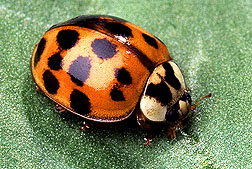For a week or so it actually looked like spring was coming, until the snow and ice descended once again. The robins and song sparrows and redwings are still out in the snowy yard, looking a bit forlorn but singing away nonetheless. And then there are the signs of spring from inside the building – scores of ladybugs crawling on the windows on sunny days. And the walls, the floor, all over the place. Good grief. Although they are members of the genus Harmonia, their abundant presence brings about anything but harmony. Rather, they usually result in the emergence of the vacuum cleaner.
Most old buildings serve as winter refuges for what are technically the multicolored Asian lady beetle, Harmonia axyridis,

Asian lady beetle
which are considered perhaps the most invasive insect on Earth. They are not one of our native lady beetles, of which there are many species that have lived harmlessly here for eons and are important components of our local ecosystems. The native lady beetles are smaller and are adapted to a particular ecological niche in the world. They tend to be predators of smaller insects, and are quite specialized in their roles in our forests and fields.
The multicolored Asian lady beetles, however, are large and apparently vary adaptable. They are indeed native to eastern Asia but have a large natural range from southern China north to Siberia and west to Mongolia. People have extended their range greatly either intentionally or unintentionally, and they are now found on at least four continents and across all of North America, where they were brought and released to control aphids in the South years ago. It was thought that they wouldn’t be able to tolerate the cold of our region, but as they say in Jurassic Park, “nature finds a way”.
The multicolored Asian lady beetles are active, aggressive, and seem to prefer meadow habitats in which to hunt their prey. They are good fliers, moving from plant to plant to look for all sorts of small insects to consume. They reproduce continuously, each female laying about 25 eggs per day during the warm months. The eggs hatch larvae which look like spiky dark caterpillars which also predate small insects, including eggs and other larvae of their own kind. Adults live about 30 to 60 days, except for those which hatch when the days become shorter – 10 to 13 hours of daylight, which induces diapause or a hold on their reproduction plus the urge to seek a sheltered place in which to spend the cold months. Old houses and buildings with cracks and openings offer perfect refuge, unfortunately.
Asian ladybugs have some other interesting traits that we notice when they enter our houses – they stink and they can bite. One of their defenses is to exude fluid from joints in their legs when they are alarmed. The fluid contains nasty smelling and tasting substances that deter predators. This odor is imparted into one’s vacuum when cleaning up the insects and becomes a permanent reminder of their seasonal visits to our houses. They also like to hang around vineyards, and if harvested with grapes can impart a bad taste to wine. Thankfully, most of them don’t bite, although their large mandibles can produce a surprising pinch. Rather, one occasionally seems to decide to taste us- one theory is that they have a taste for salt on our skin. Out of the hundreds I’ve encountered at the nature center and at home this winter, only one has decided to see how salty I taste, fortunately.
These insects have a lot of common names – including the harlequin beetle and Halloween beetle because they like to come indoors in late fall. They are extremely variable in appearance- sporting a wide variety of colors and color patterns from orange spotted with black to no spots to black spotted with orange. Almost all have white cheeks, patches on the sides of their thorax, or, second body segment. And although they are just a nuisance to us, they may be devastating to our native lady beetles, outcompeting and driving them out of existence. It is hard to imagine a ladybug as a bully, but like most invasive species that’s how they behave. And like many of the invasives, there will be no putting this genie back in it’s bottle- they are most likely here to stay unless a more potent bully comes along.
So do your best to caulk the openings in your house, and keep the vacuum handy. And, get used to the fact that you will always have lots of company at your windowsill on these first sunny days of spring.
photo- lady beetle from USDA
